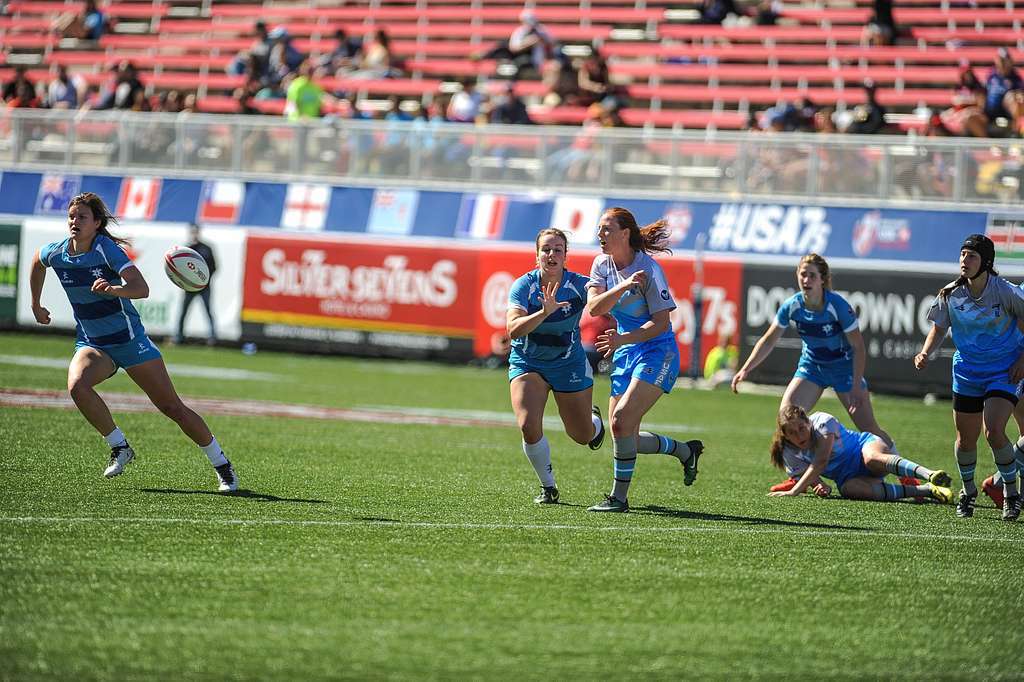Introduction
Passing is a fundamental skill in rugby, and accuracy is crucial for successful team play. Whether you’re a seasoned player or a beginner looking to improve, mastering the art of accurate rugby ball passing is essential. In this comprehensive guide, we will delve into the key components of an accurate pass, the various types of passes used in rugby, and the techniques required to execute them effectively. By the end of this article, you’ll have the knowledge and confidence to deliver precise passes that can turn the tide of a game in your team’s favor.
1. The Essentials of an Accurate Pass
An accurate pass in rugby involves delivering the ball directly to the intended recipient with precision and speed. Several elements contribute to a successful pass:
Grip
The first step to an accurate pass is getting the grip right. Hold the rugby ball with both hands, using your fingers to grip the ball’s seams. Your hands should be spread across the ball’s surface, providing stability and control. Keep your thumbs pointing towards each other and close to the ball to prevent the pass from wobbling.
Body Positioning
Proper body positioning is crucial for a successful pass. Stand with your feet shoulder-width apart, knees slightly bent, and body facing the target. Align your hips and shoulders with the direction of the pass. A stable stance ensures a solid foundation for generating power and accuracy in your pass.
Passing Technique
The passing technique varies based on the distance and situation. The two most common passes are the “chest pass” and the “spin pass”:
Chest Pass
The chest pass is the basic pass used for short to medium distances. Hold the ball with both hands at chest level and push it directly towards the target. Follow through with your arms to maintain accuracy and power.
Spin Pass
The spin pass is ideal for longer distances and requires a rotational motion to generate speed. Hold the ball across your body, with your non-throwing hand at the front and your throwing hand at the back. Step forward with your front foot and rotate your hips and shoulders as you pass the ball. This action imparts spin on the ball, stabilizing its trajectory and increasing accuracy.
2. Perfecting Your Passing Technique
Accurate passing demands consistent practice and attention to detail. Focus on these key areas to improve your passing technique:
Hand-Eye Coordination
Developing excellent hand-eye coordination is essential for accurate passing. Practice passing against a wall or with a partner, focusing on tracking the ball from your hands to its destination. This helps refine your accuracy and reaction time during gameplay.
Passing Under Pressure
In a rugby match, passing accuracy is often tested under pressure from defenders. Create game-like scenarios during training sessions, where you have limited time to pass while under the watchful eyes of defenders. This will improve your decision-making and passing skills in challenging situations.
Off-Hand Passing
Being proficient in passing with both hands makes you a more versatile player. Work on your off-hand passing regularly to ensure you can deliver accurate passes in any direction, regardless of the situation.
Passing on the Move
In a dynamic sport like rugby, accurate passing while moving is essential. Incorporate passing drills that involve running, changing direction, and passing accurately on the go. This simulates real-game scenarios and enhances your ability to pass under different conditions.
3. Understanding Types of Passes
Rugby offers a variety of passes to suit different game situations. Understanding and practicing these types of passes will make you a well-rounded player:
Pop Pass
The pop pass is a quick, short-distance pass used to offload the ball to a nearby teammate while engaging defenders. Hold the ball with both hands near your chest and pop it to your target by extending your arms forcefully. This pass is effective when you’re close to the opposition’s defensive line.
Loop Pass
The loop pass is a strategic pass used to exploit gaps in the defensive line. It involves two players—usually a forward and a back—running in sync towards the opposition’s defensive line. The forward then passes the ball behind the back to the supporting back, who continues the attack. Mastering this pass adds versatility to your team’s attacking strategies.
Cut-out Pass
The cut-out pass is a long, horizontal pass used to bypass several defenders and reach teammates further down the field. Hold the ball with both hands at one end and extend your arms fully to deliver a flat, accurate pass. This pass requires practice to control the power and direction effectively.
Grubber Kick Pass
The grubber kick pass is an advanced technique used to exploit space behind the defensive line. Instead of passing directly, you kick the ball along the ground into open space for a teammate to chase. This pass requires precise execution, as an inaccurately placed grubber kick can easily be intercepted by the opposition.
4. Communication and Timing
Accurate passing isn’t solely about the technical aspect—it also involves effective communication and impeccable timing. Here’s how you can improve in these areas:
Verbal Communication
Clear and concise verbal communication is essential during a rugby match. Develop a set of standardized hand signals or call out your teammate’s name when passing to avoid confusion and ensure accurate deliveries.
Visual Communication
Use eye contact and body language to communicate with your teammates. Make your intentions clear by looking at your target before passing, which helps the recipient anticipate the ball’s arrival and adjust their positioning accordingly.
Timing
Timing is crucial for accurate passes, especially when executing complex maneuvers. Practice passing drills with your teammates to develop a sense of each other’s movements and improve the timing of your passes.
5. Game Awareness and Decision Making
Accurate passing is closely tied to game awareness and decision-making skills. Here are some tips to enhance these aspects of your gameplay:
Read the Defense
Understanding the defensive formation and identifying gaps in the opposition’s line helps you make better passing decisions. Analyze the defensive patterns and communicate them with your teammates to exploit weaknesses effectively.
Keep It Simple
While flashy passes can be exciting, simplicity often trumps complexity in rugby. Make accurate, straightforward passes that reach your teammates efficiently. Fancy maneuvers may lead to turnovers and lost opportunities.
Stay Composed Under Pressure
Rugby is a fast-paced and physically demanding sport, but maintaining composure under pressure is crucial for accuracy. Keep a clear head, focus on your technique, and make smart decisions even in high-pressure situations.
6. Video Analysis and Feedback
Recording your gameplay and analyzing it later is a powerful tool for improvement. Look for areas where your passing accuracy can be enhanced. Seek feedback from coaches or experienced players to gain valuable insights into your technique and decision-making.
Great Passing Drills for Accuracy
Passing accuracy is a crucial skill in rugby that can make a significant difference in a team’s performance. To improve your passing accuracy, you need to incorporate specific drills into your training routine. These drills focus on enhancing your technique, decision-making, and ability to execute accurate passes under pressure. Here are some great passing drills that will take your passing game to the next level:
1. Wall Passing Drill
The wall passing drill is a simple yet effective way to work on your passing accuracy and hand-eye coordination. All you need is a rugby ball and a flat wall.
Instructions:
- Stand a few meters away from the wall, facing it.
- Hold the ball with both hands, and pass it against the wall with the intention of catching the rebound.
- Focus on delivering precise and flat passes to ensure the ball returns directly to you.
- Vary the distance from the wall and the angle of your passes to challenge yourself.
This drill helps you develop muscle memory for accurate passing and encourages quick reactions when receiving the ball.
2. Moving Target Drill
The moving target drill simulates game scenarios where you need to pass accurately to a moving teammate. For this drill, you’ll need at least three players and a set of cones.
Instructions:
- Set up a square or rectangular grid using the cones.
- One player stands in the center of the grid, acting as the passer, while the other two players move around the grid as moving targets.
- The passer must pass the ball accurately to either of the moving targets as they change their positions continuously.
- The targets can walk, jog, or run to create different levels of difficulty.
- After a set time, rotate positions so that each player gets a chance to be the passer and the moving target.
This drill improves your passing accuracy while on the move and helps you adapt to the dynamic nature of a rugby game.
3. Decision-Making Passing Drill
In rugby, making the right decisions under pressure is crucial for accurate passing. This drill helps you improve your decision-making skills while honing your passing accuracy.
Instructions:
- Set up a small grid with four cones to form a square.
- Position two players inside the square, one acting as the passer and the other as the receiver.
- Place two defenders outside the grid, positioned to put pressure on the passer.
- The passer has to decide quickly whether to pass the ball to the receiver inside the grid or perform a dummy pass to evade the defenders before making the accurate pass.
- Rotate positions regularly, allowing each player to experience being the passer, receiver, and defender.
This drill enhances your ability to make quick and accurate decisions during gameplay, ensuring your passes reach their intended targets despite defensive pressure.
4. Over-the-Line Passing Drill
The over-the-line passing drill focuses on delivering long and accurate passes. It helps improve your technique for executing cut-out passes, which are essential for bypassing multiple defenders.
Instructions:
- Set up two lines of players facing each other, about 15 to 20 meters apart.
- The players in one line are the passers, while the players in the other line are the receivers.
- The passers aim to deliver long, flat, and accurate passes over the heads of the defenders to the receivers on the opposite line.
- The receivers catch the ball and return it to the passer, creating a continuous flow of passing.
This drill enhances your passing distance, accuracy, and timing, ensuring you can execute cut-out passes effectively during a game.
5. 3-on-2 Continuous Passing Drill
The 3-on-2 continuous passing drill is an excellent way to work on your passing accuracy under pressure, as well as your ability to exploit numerical advantages.
Instructions:
- Divide the players into two teams—one team with three players and the other with two players.
- Set up a small playing area with cones.
- The team with three players has possession of the ball and aims to keep possession by passing accurately among themselves.
- The team with two players acts as defenders and tries to intercept the ball or force turnovers.
- If the defending team wins possession, they become the attacking team, and the previous attackers become defenders.
- The drill continues with continuous passing, and the roles of the attacking and defending teams alternate.
This drill sharpens your passing accuracy under pressure and encourages quick decision-making in a dynamic game-like scenario.
Conclusion
Passing accuracy is a fundamental skill in rugby that can significantly impact your team’s performance. Incorporate these passing drills into your training routine to improve your technique, decision-making, and ability to pass accurately under pressure. Regular practice and dedication to honing your passing skills will make you a valuable asset to your team, as accurate passes lay the foundation for successful attacking plays and overall gameplay. Remember that practice makes perfect, so stay committed to improving your passing accuracy, and watch as your skills positively influence your team’s success on the rugby field.

